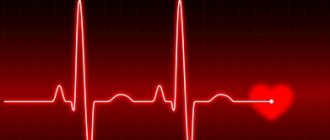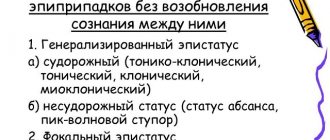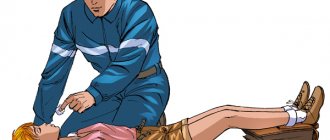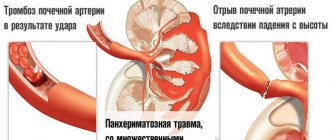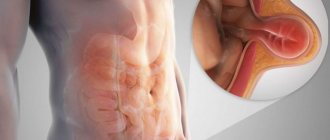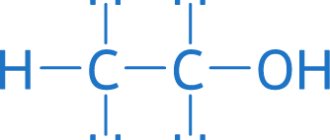Causes of the condition
Cardiac asthma is the second name for acute failure of the pumping function of the left chambers of the heart. The occurrence of pathology may be associated with diseases of the cardiovascular and other systems; the main reasons are presented in the table.
| Cardiac (associated with left ventricular weakness) | Extracardiac (the appearance of disorders is caused by increased vascular permeability) |
|
|
The diagnosis of cardiac asthma is most often made at the prehospital stage of emergency care, which requires a differential approach to treatment depending on the underlying cause.
Cardiac asthma: can it be prevented?
Cardiac asthma manifests itself in the form of attacks of suffocation and shortness of breath caused by left ventricular failure. This leads to stagnation of blood in the pulmonary circulation. Blood plasma penetrates the bronchi and lung tissue, causing pulmonary edema and causing suffocation and difficulty breathing. This pathology requires emergency medical care; if the attack is not stopped quickly, it can be fatal.
Main signs and symptoms
The pathogenesis of the development of symptoms of cardiac asthma is realized through:
Decreased pumping function of the heart. Adequate blood flow to the left chambers and the absence of outflow contributes to the accumulation of fluid in the vessels of the lungs, with an increase in the volume in which the permeability of the wall increases. An increase in hemodynamic pressure “pushes” plasma into the intercellular space (interstitium) with further sweating into the alveolar cavities.- Increased permeability of the vascular wall against the background of other pathologies in which pulmonary edema can develop with preserved or minimally reduced cardiac function.
Swelling
Edema is a pathological accumulation of fluid in tissues that develops due to impaired lymphatic or venous outflow.
Features in acute heart failure:
- first, swelling of the neck area develops with difficulty breathing;
- swelling of the saphenous veins (jugular veins);
- swelling is cold, dense with a bluish tint;
- the liver increases in size (hepatomegaly).
- free fluid in the abdominal and chest cavity, pericardium.
The development of edema in cardiac asthma is associated with a decrease in the function of the right sections (due to impaired outflow along the pulmonary trunk), and stagnation of blood in the superior and inferior vena cava system.
Choking and coughing
The occurrence of symptoms from the respiratory system is caused by a decrease in the respiratory surface of the lungs due to the accumulation of fluid in the alveoli. Main features:
- dyspnea;
- suffocation;
- cough;
- hemoptysis.
The difference between the concepts of “shortness of breath” and “suffocation” lies in the severity and severity of symptoms.
Choking is an extreme form of breathing disorder, which is accompanied by a feeling of lack of air and fear of death.
Cough is one of the most common signs of pulmonary edema. Main symptom characteristics of cardiac asthma:
- constant (rarely in the form of attacks);
- sputum - mucous in moderate quantities, often mixed with blood (due to increased pressure in the chest cavity during coughing, bronchial arterioles rupture);
- secretion of foam (blood plasma contains a large amount of protein, which “foams” with sharp and fast air flows during coughing).
The appearance of cough in patients with cardiac asthma is caused by irritation of mechanical receptors in the bronchioles and the “need” to empty the lungs of fluid.
Dyspnea
Symptoms of cardiac asthma include shortness of breath as one of the key manifestations of the pathology, which is characterized by difficulty inhaling and exhaling, an increase in the frequency of respiratory movements and a feeling of lack of air.
Features of dyspnea of cardiac etiology:
- mixed type (as opposed to an attack of bronchial asthma, when exhalation is difficult);
- progression;
- patients take a forced orthopneic position - half-sitting with the lower limbs lowered and leaning on the shoulder girdle;
- the skin is pale, cold with sticky sweat.
X-ray examination of the chest organs with such symptoms is characterized by a picture of “wet lungs” with a diffuse decrease in the transparency of the fields, a blurred vascular pattern.
Heart pain and arrhythmia
Cardiac symptoms in acute circulatory failure most often arise due to a cardiac cause of the pathology.
Main manifestations:
rapid heartbeat (tachycardia);- pain behind the sternum, pressing in nature, lasting more than 20 minutes;
- a feeling of interruptions in the work of the heart (constant or paroxysms), sudden stops or extraordinary contractions;
- loss of consciousness (due to a sudden decrease in blood pressure, development of cardiogenic shock).
Diagnosis of rhythm disturbances and the choice of medications for relief are carried out based on the results of electrocardiography (ECG) recorded in 12 leads.
Diagnosis and treatment
For proper treatment, it is important to differentiate cardiac asthma from bronchial asthma, acute laryngeal stenosis, and from shortness of breath in other diseases. Only an experienced doctor can make a correct diagnosis, excluding similar diseases. Diagnosis begins with analysis of data from an objective examination and collection of anamnesis. Hardware and laboratory tests are prescribed:
- chest x-ray; c
- electrocardiographic study;
- echocardiography;
- ABPM – daily blood pressure monitoring;
- ultrasonography;
- spirography (to exclude bronchial asthma);
- General and biochemical blood test.
If you have an attack of cardiac asthma due to the high risk of developing pulmonary edema, you must urgently call a doctor. The main way to combat the disease is medical conservative treatment; hirudotherapy also has a good effect. For cardiac asthma, inhalations are indicated to help reduce pulmonary edema.
For cardiac asthma with rhythm disturbances, electropulse therapy is used; in case of valve disease, consultation with a cardiac surgeon and surgical intervention are indicated.
Make an appointment (video consultation available)
Your message has been sent
Thank you for contacting Multidisciplinary Medical!
Your message will be processed shortly and we will contact you to clarify the details.
Be healthy!
Join us on social networks!
Current news, promotions, useful information.
How to find us
OUR ADDRESS
Moscow, st. Shchukinskaya, 2
Shchukinskaya, Streshnevo, Sokol
TELEPHONE
+7
First aid to the patient: a short algorithm
Cardiac asthma is an indication for emergency transportation of the victim to a cardiology hospital or intensive care unit of a specialized center.
At the pre-medical stage it is necessary:
- call an emergency medical team (EMS);
- provide the patient with a free flow of oxygen (unfasten tight collars, open windows);
- give a semi-sitting position, lowering the lower limbs (for patients with low blood pressure - horizontal);
- if there is a history of coronary heart disease - Nitroglycerin or Isoket under the tongue;
- measure blood pressure; if the readings are low, apply venous tourniquets alternately to the arms and legs. It is forbidden to remove it abruptly - due to the risk of developing cardiogenic shock.
Timely (within the first 30 minutes) elementary methods of emergency care improve the prognosis for the patient: survival rate increases by 2 times.
The use of folk remedies to relieve cardiac asthma is strictly prohibited.
Upon arrival of the ambulance, the patient is provided with venous access (catheter) and painkillers are administered (Promedol, Morphine).
Emergency actions for pulmonary edema
Emergency care for cardiac asthma during hospitalization involves a set of measures that are aimed at increasing the pumping function of the heart and compensating for existing disorders (symptomatic therapy).
According to the protocol, in a hospital setting the following is carried out:
- oxygen therapy (depending on the patient’s condition: through a mask or in artificial ventilation mode);
- in the presence of hemoptysis with pink foamy sputum, use antifoam agents (Antifomsilan) using a special inhaler;
- diuretic therapy: Furosemide intravenous bolus 40 mg (Torasemide - 20 mg);
- vasodilators: intravenous Nitroglycerin – allowed when systolic blood pressure increases more than 110 mmHg;
- if there are signs of bronchial obstruction: Prednisolone, Theophylline;
- inotropic support (increasing the strength of heart contractions): Dopamine through a syringe injector at a dose of 3-5 mcg/kg/min, Dobutamine 2-20 mcg/kg/min;
- cardiac glycosides (if there is supraventricular paroxysmal tachycardia, atrial fibrillation on the ECG) - Digoxin.
Anticoagulant therapy is recommended for patients with acute coronary syndrome, atrial fibrillation, artificial valves, and deep vein thrombosis. Effective drugs are low molecular weight heparins (Enoxyparin, Fraxyarin, Deltaparin), which are administered subcutaneously at the rate of 0.1 ml per 10 kg of human weight.
Antiarrhythmic therapy is prescribed depending on the form of the disorder:
- ventricular fibrillation - electrical pulse therapy (up to 360 J), intravenously - 150-300 mg of Amiodarone, 1 mg of Adrenaline according to resuscitation recommendations;
- sinus or supraventricular tachycardia: Metoprolol;
- atrial fibrillation: Digoxin 0.125-0.25 mg intravenously, Amiodarone 150 mg, anticoagulant therapy is required;
- bradycardia (reduced heart rate): Atropine 0.25-0.5 ml, Isoprenaline 2-20 mcg/kg/min.
After relief of the acute disorder, the patient remains in the intensive care unit for 3 days, followed by transfer to a cardiology hospital to prevent possible relapses, rhythm disturbances and complications.
Causes of the disease
Factors provoking pathology are:
- Cardiac ischemia;
- Mitral stenosis;
- Cardiac aneurysm;
- Acute myocardial infarction;
- Exacerbation of chronic glomerulonephritis;
- Post-infarction conditions;
- Paroxysm of atrial fibrillation;
- Cardiosclerosis;
- Defect or deficiency of the heart valves;
- Atrial flutter;
- Heart failure provoked by increased physical activity, horizontal body position or intravenous administration of a large volume of fluid;
- An increase in the blood mass filling the vessels.
Treatment: what pills to take to prevent complications
Secondary prevention of cardiac asthma involves preventing the progression of pathology and the development of undesirable consequences. Such patients are prescribed basic (basic) and symptomatic drug support depending on the primary disease:
antiplatelet therapy: Aspirin 75 mg/day – for life;- nitroglycerin 0.0005 mg - under the tongue when an angina attack occurs;
- in case of lipid imbalance – Atorvastatin 20 mg/day;
- angiotensin-converting enzyme inhibitors (patients with arterial hypertension) – Lisinopril 10 mg/day;
- diuretic therapy: Spironaloctone 50 mg/day;
- patients with atrial fibrillation - indirect anticoagulants (Sinkumar, Warfarin), the dose of which is selected individually under the control of the state of the blood coagulation system.
Patients with impaired pumping function of the heart are monitored by a cardiologist, which means regular examinations, laboratory and instrumental studies, and periodic adjustment of drug doses.
Treatment
Treatment of cardiac asthma requires changes in the patient's lifestyle. The most effective measures include the following:
- Losing body weight to normalize blood pressure and general well-being.
- Following a special diet with minimal salt content. The patient is also advised to avoid any canned foods.
- Oxygen therapy.
- Sometimes doctors prescribe diuretics, which help remove fluid from lines.
- In the most severe cases, ultrafiltration is prescribed to cleanse the blood of excess fluid.
With proper treatment that affects the cause of the disease, the symptoms of cardiac asthma subside and the risk for the patient is reduced.
Characteristic symptoms
Cardiac asthma attacks most often occur at night. They are accompanied by:
- Dry cough;
- By suffocation;
- Cyanosis, that is, blue discoloration of the fingertips, face and nasolabial triangle;
- Pale skin;
- Hard breathing caused by swelling in the lungs;
- Moist rales in the lower parts of the lungs;
- Reflex bronchospasms.
Diagnosis is complicated by the fact that similar symptoms also occur with bronchial asthma. If an attack occurs, you must immediately call a doctor.
Emergency first aid for an attack of cardiac asthma
The first step is to call an ambulance and inform the dispatcher about the age and location of the victim. It is also advisable to talk about the symptoms that the patient has. Then you should unbutton your shirt, remove your belt, tie and other accessories that block the person’s breathing.
After this, you need to open a window in the room so that the victim can breathe in fresh air, while it is advisable to turn on a fan or wave a notebook, cardboard paper or hat in front of the person’s face. These manipulations are needed to eliminate oxygen starvation in the brain.
The patient should not be in a horizontal position; he should be seated on a couch or bed so that his back rests on the back of a chair or pillow. If a person becomes ill on the street, he should be seated on a bench, high curb or stump.
When providing first aid for cardiac asphyxia, special treatment of the oral cavity is important. If the patient accumulates a large amount of foam and phlegm in the mouth, it should be removed with cotton pads or other sterile objects. It is not recommended to do this with your fingers, as this is unhygienic and the victim may reflexively clench his jaw due to pain shock.
To ease the work of the heart, normalize blood circulation and prevent pulmonary edema, you need to apply tight tourniquets to the lower and upper limbs (one limb should be without a tourniquet). After 10-15 minutes, the tourniquets should be transferred and the other limb should be left free. This manipulation must be carried out simultaneously, and the tourniquets on the lower extremities must be fixed at a distance of 15 centimeters from the groin. On the upper limbs, the tourniquet is installed at a distance of 10 centimeters from the shoulder joint.
If the procedure was carried out correctly, the pulse will be felt just below the applied bandage. Due to manipulation, the skin should become red-bluish. The duration of the procedure varies from 5 to 30 minutes. During an attack of cardiac asthma, tourniquets can be replaced with hot baths for the lower extremities. This manipulation will help reduce blood flow to the heart.
If a person does not get better, he needs to be urgently hospitalized for medical care. Even if the victim’s health has improved, it is necessary to consult a specialist and undergo an examination to find out the cause of suffocation. After delivering the patient to a medical facility, the cardiologist will conduct a general diagnosis of the whole body. First of all, the specialist will talk with the patient, find out about the symptoms and the attack, then the doctor will need test results: electrocardiogram, chest x-ray, ultrasound of the heart, magnetic resonance imaging to detect problems and hidden diseases. After the examination and receipt of research results, the patient is sent to the attending physician, who makes an accurate diagnosis and prescribes a comprehensive course of therapy.
